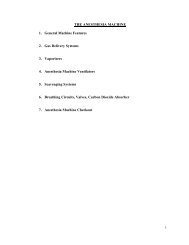BUMC Basics.pdf - Anesthesia Home
BUMC Basics.pdf - Anesthesia Home
BUMC Basics.pdf - Anesthesia Home
You also want an ePaper? Increase the reach of your titles
YUMPU automatically turns print PDFs into web optimized ePapers that Google loves.
29<br />
CARDIOLOGY<br />
CCU IN GENERAL<br />
You are typically called for the following patients:<br />
• Patient in the cath lab having a stent placed 2/2 STEMI:<br />
You can go to the cath lab and watch the cath, or you may not<br />
meet them until recovery or when they get to the CCU. These<br />
patients typically come out with post-cath orders filled out by<br />
the cardiologist or fellow, but you sometimes also fill these out<br />
if you are there early in the process. You are then responsible<br />
for getting the HPI and adding additional orders/meds.<br />
• Patient transferring from OSH 2/2 MI s/p lytics: These<br />
patients will need orders as below for ACS, but no GpIIb/IIIa<br />
inhibitors. You will likely do H&P and initial orders and then talk<br />
with the cardiologist then or in the A.M. (if the patient comes in<br />
the night) whether they need to go to cath.<br />
• Patients in the ER with UA/NSTEMI: See management<br />
below<br />
• Decompensated CHF patients with pulmonary edema in<br />
the ER: Follow CHF order set and treat pulmonary edema as<br />
below in pulmonary edema section.<br />
ACUTE CORONARY SYNDROME<br />
Stable Angina: Chest pain resulting from imbalance of<br />
oxygen supply and demand to cardiac<br />
tissue. Usually happens at the same<br />
frequency, intensity, and duration. Most<br />
common cause is CAD; other causes include<br />
aortic valvular disease, HCM, and coronary<br />
artery spasm. This is due to a stable plaque.<br />
UA/NSTEMI: New onset of severe angina, angina at rest<br />
or with minimal activity, or recent increase in<br />
frequency and or intensity of stable angina. If<br />
patient has positive cardiac markers<br />
(necrosis) without ST elevation, then this is<br />
defined as NSTEMI. This is due to a partially<br />
occluding thrombus.




